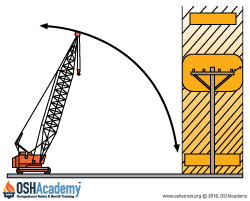Electrocution Hazard Protective Measures
Maintain Safe Distance from Overhead Power Lines
Staying away from power lines is the best option when working near power lines. The following Power Line Clearance Distances table below shows the safe power line clearance distances for various line voltages. For instance, if you are working near a 138 kV transmission line, the minimum safe clearance distance would be 15 feet.
| Voltage (nominal, kV, alternating current) | Minimum clearance distance (feet) |
|---|---|
| Up to 50 | 10 |
| Over 50 to 200 | 15 |
| Over 200 to 350 | 20 |
| Over 350 to 500 | 25 |
| Over 500 to 750 | 35 |
| Over 750 to 1000 | 45 |
| Over 1000 | (As established by the power line owner/operator or registered professional engineer who is a qualified person with respect to electrical power transmission and distribution) |
Safe Practices Working Near Powerlines
The following are preventive measures for workers. Before work begins, make sure:
- equipment/activity is located within a safe working distance from power lines;
- the utility company has de-energized and visibly grounded the power lines or installed insulated sleeves on power lines;
- flagged warning lines have been installed to mark horizontal and vertical power line clearance distances; and
- tools and materials used are nonconductive.
Knowledge Check Choose the best answer for the question.
8-1. What is the minimum clearance distance when working near a 138 kV transmission line?
You forgot to answer the question!

